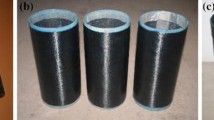Abstract
The confinement of concrete columns provided by carbon fibre reinforced plastic (CFRP) sheets can be an efficient technique for their structural strengthening. The principal advantages of this technique are the high strength-to-weight ratio, good fatigue properties, non-corroding characteristics of the CFRP, and the facility of its application.
An experimental research program, that included tests on 54 short column specimens, was carried out to investigate the gain in strength and ductility of concrete columns externally confined by CFRP wrapping. The variables studied were the column cross section shape (circular, square and rectangular) and the amount of confinement expressed in the number of CFRP sheet layers applied to the models (one or two layers).
On the basis of the obtained results, equations were proposed to calculate the confined concrete strength and the ultimate confined concrete strain as a function of the confining lateral stress for each of the cross section geometry used, circular, square and rectangular. The estimations given by these equations and by those from formulas encountered in the literature were compared with the experimental ones and general conclusions were, finally, drawn.
Résumé
Le confinement de colonnes de béton assuré par des feuilles de plastique renforcé par des fibres de carbone (CFRP) peut être une technique efficace pour leur comportement structural. Les principaux avantages de cette technique sont la haute relation résistance-poids, des bonnes propriétés de fatigue, les caractéristiques non-corrosives du CFRP, et la facilité de leur application.
Un programme expérimental comprenant des essais sur 54 colonnes courtes fut entrepris en vue de déterminer le gain de résistance et de ductilité de colonnes en béton confinées sur le plan externe en les recouvrant de feuilles de CFRP. Les variables étudiées étaient la forme de la section transversale (circulaire, carrée et rectangulaire), et la quantité de renforcement, mesurée par le nombre de feuilles de CFRP appliquées aux modèles (une ou deux couches).
En prenant comme base les résultats obtenus, des équations ont été proposées pour calculer la résistance du béton confiné et sa déformation spécifique ultime en fonction de la contrainte latérale de confinement, pour chaque forme de section transversale utilisée, circulaire, carrée et rectangulaire. Les estimations données par ces équations et celles données par des formules trouvées dans la litérature ont été comparées avec les résultats expérimentaux et des conclusions générales ont finalement été établies.
Similar content being viewed by others
References
Considerè, A., ‘Experimental researches reinforced concrete’, L. F. Moisseiff, translator, MacGraw-Hill, New York, N.Y., (1903).
Comité Euro-International du Béton, ‘High Performance Concrete’ Bulletin d'Information 228, (July 1995).
Hosotani, M., Kawashima, K. and Hoshikuma, J., ‘A study on confinement effect of concrete cylinders by carbon fiber, sheets’, Non-Metallic (FRP) Reinforcement for Concrete Structures, Proceedings of the Third International Symposium, v. 1, (Oct 1997), 209–216.
Karbhari, V. M. and Gao, Y., ‘Composite jacketed concrete under uniaxial compression—Verification of simple design equations’,Journal of Materials in Civil Engineering, ASCE 9 (4) (1997) 185–193.
Kawashima, V. M., Hosotani, M. and Hoshikuma, J., ‘A model for confinement effect for concrete cylinders confined by carbon fiber sheets’, NCEER-INCEDE Workshop on Earthquake Engrg. Frontiers of Transp. Fac., NCEER, State University of New York, Buffalo, N.Y., (1997).
Matthys, S., ‘Structural behaviour and design of concrete members strengthened with externally bonded FRP reinforcement’, Doctor of Applied Sciences Thesis, Ghent University, Belgium, (2000).
Mirmiran, A. and Shahawy, M., ‘Behavior of concrete columns confined by fiber composites’,Journal of Structural Engineering, ASCE 123 (5) (1997) 583–590.
Miyauchi, K., Nishibayashi, S. and Inoue, S., ‘Estimation of strengthening effects with carbon fiber sheet for concrete comum’, Non-Metallic (FRP) Reinforcement for Concrete Structures, Proceedings of the Third International Symposium, v. 1, (Oct. 1997), 217–224.
Picher, F., Rochette, P. and Labossière, P., ‘Confinement of concrete cylinders with CFRP’, Proc. First Int. Conf on Compos. Infrastructures, Tucson, Arizona, (1996), 829–841.
Richart, F. E., Brandtzaeg, A. and Brown, R. L., ‘A study of the failure of concrete under combined compressive stresses’, Engrg. Experimental Station Bull. No. 185, University of Illinois, Urbana, Ill., (1928).
Rochette, P. and Labossière, P., ‘Axial testing of rectangular column models confined with composites’,Journal of Composites for Construction 4 (3) (Aug. 2000) 129–136.
Saafi, M., Toutanji, H. A. and Li, Z., ‘Behavior of concrete columns confined with fiber reinforced polymer tubes’,ACI Materials Journal,96 (4) (1999) 500–509.
Samaan, M., Mirmiran, A. and Shahawy, M., ‘Model of concrete confined by fiber composites’Journal of Structural Engineering, ASCE 124 (9) (1998) 1025–1031.
Spoelstra, M. R. and Monti, G., ‘FRP-confined concrete model’,Journal of Composites for Construction, ASCE 3 (3) (1999) 143–150.
Toutanji, H. A., ‘Stress-strain characteristics of concrete columns externally confined with advanced fiber composite sheets’,ACI Materials Journal 96 (3) (1999) 397–404.
Watanabe, K., Nakamura, H. and Honda, Y.et al., ‘Confinement effect of FRP sheet on strength and ductility of concrete cylinders under uniaxial compression’, Non-Metallic (FRP) Reinforcement for Concrete Structures, Proceedings of the Third International Symposium, v. 1, (Oct. 1997) 233–240.
Xiao, Y. and Wu, H., ‘Compressive behavior of concrete confined by carbon fiber composite jackets’,Journal of Materials in Civil Engineering 12 (2) (May 2000) 139–146.
Author information
Authors and Affiliations
Rights and permissions
About this article
Cite this article
Shehata, I.A.E.M., Carneiro, L.A.V. & Shehata, L.C.D. Strength of short concrete columns confined with CFRP sheets. Mat. Struct. 35, 50–58 (2002). https://doi.org/10.1007/BF02482090
Received:
Accepted:
Issue Date:
DOI: https://doi.org/10.1007/BF02482090




